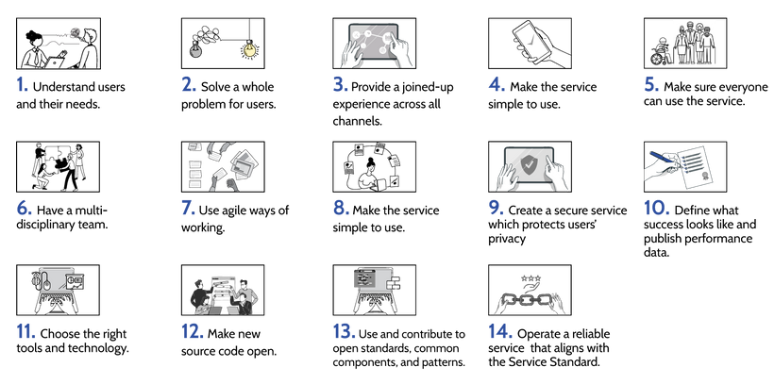This article is part of the Report on Customer Experience in Government: Trends and Case Studies, a comprehensive publication by the International Foundation for Customer Experience in Government. The report aims to advance the global dialogue on Customer Experience (CX) in the public sector, highlighting innovative practices from around the world and establishing benchmarks to help governments strengthen their CX initiatives.
CASE STUDY: UK SERVICE STANDARD
INTRODUCTION
The UK Service Standard 27 was first introduced in 2014, initiated by Government Digital Service as the central digital service development unit under the Cabinet Office. The latest iteration was launched in 2019 and includes 14 principles for alignment in government.
This initiative was a response to the political attention towards improving the service experience. At the time, it was openly believed that normal people often found it difficult to use government services: they were too hard to use, too complicated, “and include too much jargon” 28 . The first iteration of work focused mainly on the digital service experience with a digital-by-default approach.
DESCRIPTION OF THE INITIATIVE
The UK Service Standard is a centralized standard consisting of principles and guidelines that help teams create and run exceptional public services 29. The principles are:

Presently, adherence to this established standard has become customary practice, evolving towards a broader customer-centric and service-oriented framework encompassing digital services and channels beyond CX. The latest version introduces the principle of “Solve a whole problem for users” 30 , guiding enhancements not only in digital realms but extending to multiple services and even external agencies in response to user needs.
The standard’s integration is fortified by a series of governance and support mechanisms. Notably, agencies are supported in meeting the standard through comprehensive measures, including open-access resources, training, a platform for sharing best practices, and collaborative co-creation opportunities. Moreover, a dedicated unit within the Cabinet Office, the Central Digital and Data Office, takes a proactive role in standard development and enforcement, ensuring accountability.
Crucially, the standard’s application is bolstered by financial considerations. Funding approval for digital services hinges on alignment with the Service Standard. Furthermore, all digital services must be accessible via the common channel gov.uk, subject to rigorous quality and technical controls, which encompass adherence to the Service Standard’s prerequisites before services are published or updated.
SUCCESS FACTORS
Several key success factors contributed to the effectiveness of the program:
- High-Level Backing for Change: The push for change came from the top-down, with the Prime Minister and Cabinet Minister spearheading the commitment to boost government services. This showcased a strategic drive toward CX’s goals.
- Practical Guidance: The Service Standard provides crystal-clear principles and comes with practical resources such as guidelines and manuals. These help agencies build the capacity needed to meet requirements effectively.
- Focused Leadership: The Central Digital and Data Office took charge of the initiative, ensuring agencies stay on track and are accountable. In addition to ensuring compliance with set standards, this agency was the main driver of change.
MAIN CHALLENGES
While the program achieved significant success, it also encountered some challenges:
- Extended Oversight Needed: While current standards and governance mainly focus on initial service design and launch, they often move on quickly to other issues as a result of not having the time or resources to attend to post-launch phases. Agencies are left largely self-directed in pursuing further service developments, necessitating enhanced guidance in this crucial stage.
- Holistic Improvement Perspective: Continuous CX enhancement across the government mandates a comprehensive customer-centric overview of services. Despite existing data on service performance, a holistic, comparable dataset and methodology remain absent, potentially hindering comprehensive progress assessment.
- Real-World Limitations: The scope of the standard is bounded by technological, legal, and practical readiness. Certain services, like fully digital document signing, face constraints due to existing limitations even within the advanced UK ecosystem.
TAKEAWAYS
The program offers valuable takeaways for successful government initiatives:
- Establishing Clear Standards: Defining unequivocal service standards and securing strong political endorsement for practical adoption is imperative.
- Governance-Driven Enforcement: The implementation of standards should be enforced through governance mechanisms, potentially linking funding or service access to their adoption.
- Strengthening Implementation Capacity: Ensuring effective standard implementation requires robust support and capacity building, providing guidance to agencies even when the principles are already established.
The next Service Standard version aims for end-to-end service inclusion, crossing agency boundaries and addressing collaboration challenges.
In our next article, discover how Estonia’s digital transformation has turned it into a global leader in proactive, citizen-centric public services.
References:
27 “Service Standard.” Service Standard – Service Manual, n.d. https://www.gov.uk/service-manual/service-standard.
28 Fox, Martha Lane. “DIRECTGOV 2010 AND BEYOND: REVOLUTION NOT EVOLUTION.” Gov.UK, October 14, 2010. https://assets.publishing.service.gov.uk/government/uploads/system/uploads/attachment_data/file/60993/Martha_20Lane_20Fox_s_20letter_20to_20Francis_20Maude_2014th_20Oct_202010.pdf.
29 “Service Standard.” Service Manual, n.d. https://www.gov.uk/service-manual/service-standard.
30 Ibid.
